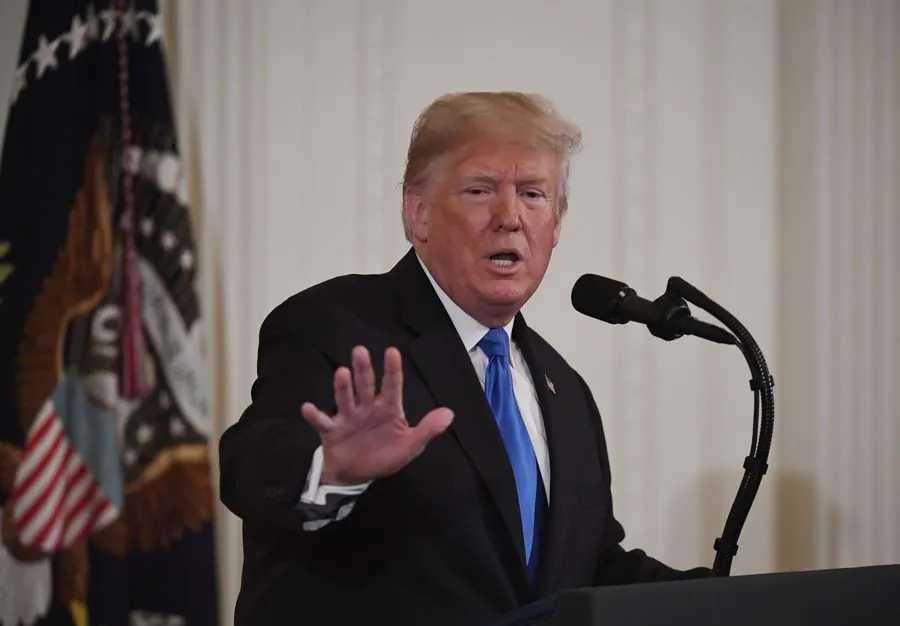U.S. President Donald Trump has ruled out the possibility of trade talks with India until the tariff issue is resolved.
When asked in the Oval Office on Thursday whether he expects trade negotiations to progress after announcing a 50% tariff on India, Trump replied, “Not until this issue is resolved.”
Last week, Trump imposed a 25% retaliatory tariff on India, which took effect on August 7.
The U.S. President also signed an executive order imposing an additional 25% tariff on India for purchasing oil from Russia, bringing the total tariff to 50%—one of the highest ever imposed by the U.S. on any country.
The additional 25% tariff will take effect after 21 days, starting August 27.
Responding to the tariffs, India’s Ministry of External Affairs stated that targeting New Delhi is “unjust and reckless.”
The ministry said, “Like any major economy, India will take all necessary steps to protect its national interests and economic security.”
Discussing the current state of India-U.S. relations, a prominent Indian-American attorney noted that “a lot is at stake” amid Trump’s tariffs.
He called it “unfortunate” that Russian President Vladimir Putin did not agree to a ceasefire in Ukraine as Trump desired.
In a post, he stated, “Harming India is equivalent to harming Russia. But this also causes significant damage to us.”
He added that the U.S. wants the Russian President to agree to a “genuine” ceasefire in Ukraine, “free of any deception,” and then have leaders like China’s Xi Jinping and India’s Narendra Modi become U.S. allies alongside Putin.
He said, “Now is the time for mature reassessment, or we risk a ‘domino effect’ that could harm everyone.”
The ‘domino effect’ refers to a chain reaction of events triggered by a single incident.
Oval Office
The Oval Office is the official workspace of the President of the United States, located in the West Wing of the White House. Designed in 1909 during President William Howard Taft’s administration, its distinctive oval shape was inspired by George Washington’s preference for neoclassical architecture. The office symbolizes presidential authority and has been the setting for many historic decisions and speeches.
India’s Ministry of External Affairs
India’s Ministry of External Affairs (MEA) is the government body responsible for managing the country’s foreign relations and diplomatic missions. Established in 1947 after India’s independence, it plays a key role in shaping foreign policy, fostering international cooperation, and safeguarding national interests abroad. The MEA also oversees initiatives like cultural diplomacy and aid programs to strengthen India’s global presence.
New Delhi
New Delhi, the capital of India, was officially established in 1911 during British colonial rule and designed by architects Edwin Lutyens and Herbert Baker. It replaced Kolkata (Calcutta) as India’s capital and features grand colonial-era landmarks like India Gate and Rashtrapati Bhavan (the Presidential Residence). Today, it serves as the political and cultural heart of modern India, blending historical heritage with rapid urbanization.
Ukraine
Ukraine, located in Eastern Europe, is a country with a rich cultural heritage and a history dating back to the medieval Kyivan Rus’ (9th–13th centuries), which is considered the cradle of Eastern Slavic civilization. It has endured centuries of foreign rule, including by the Polish-Lithuanian Commonwealth, the Russian Empire, and the Soviet Union, before gaining independence in 1991. Known for its Orthodox Christian traditions, vibrant folk art, and historic sites like Kyiv’s Saint Sophia Cathedral and the Chernobyl Exclusion Zone, Ukraine remains central to regional identity and geopolitical dynamics.
Russia
Russia, the largest country in the world, spans Eastern Europe and Northern Asia, with a rich history dating back to the 9th-century Kievan Rus’. It became a major global power under the Tsars and later the Soviet Union, playing a pivotal role in 20th-century geopolitics. Today, it is known for its diverse culture, iconic landmarks like the Kremlin and Red Square, and influential contributions to literature, music, and science.
China
China, one of the world’s oldest civilizations, has a rich history spanning over 5,000 years, marked by dynastic rule, philosophical traditions like Confucianism, and inventions such as paper and gunpowder. Today, it is a global powerhouse known for its blend of ancient cultural heritage—including landmarks like the Great Wall and the Terracotta Army—and rapid modernization. Its diverse landscapes, from bustling megacities to serene rural regions, reflect its deep historical roots and dynamic present.
India
India is a diverse and culturally rich country in South Asia, known for its ancient civilizations, vibrant traditions, and historic landmarks like the Taj Mahal and Varanasi. With a history spanning over 5,000 years, it was home to the Indus Valley Civilization, witnessed the rise of major religions like Hinduism and Buddhism, and endured British colonial rule before gaining independence in 1947. Today, it is the world’s largest democracy and a global hub for spirituality, cuisine, and heritage.
U.S.
The United States (U.S.) is a diverse and expansive country in North America, founded in 1776 after declaring independence from Britain. Known for its cultural influence, democratic government, and economic power, it is home to iconic landmarks like the Statue of Liberty, the Grand Canyon, and historic sites such as Independence Hall. Its history includes colonization, the Civil War, civil rights movements, and global leadership in technology and innovation.






